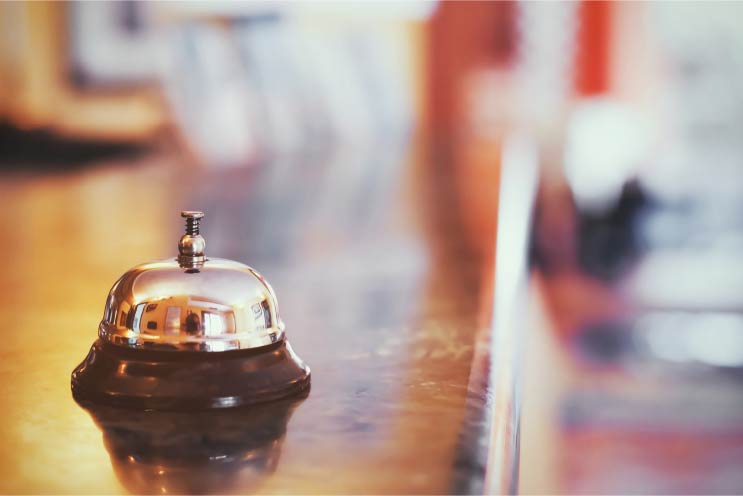 Reading Time: 12 minutes
Reading Time: 12 minutesIntroduction: The customer +hotel perspective
The hotel Industry is a subset of the hospitality Industry that deals with accommodation and related services for traveling consumers. This industry is majorly dependent on tourism and travel. The global hotels and resorts industry took a huge hit in its steady growth rate owing to the COVID pandemic and its related suspension and limitations on international travel, and consequently saw a revenue decline of 44.3%*[1]. The appetite for travel has increased ever since 2022, as travel limitations were lifted. Thanks to a phenomenon of revenge spending- revenge travel and revenge tourism in this case – people have been re-planning and executing their long-canceled travel plans.
With increasing revenues, hotels are actively looking to ensure growth in market share to capitalize on the thriving travel trends. While the hotel industry is already using data and analytics to track key performance metrics relevant to the industry, there is a need to up the game owing to these 2 critical areas:
- The emerging trends in AI, where enterprises across industries are attempting to use AI in aiding their business. The smarter businesses using AI get an upper hand in understanding the market and business trends, and hence can strategize accordingly.
- The expanding revenue streams of the hotel industry will leave the cash crunched and idea crunched businesses way behind others that are going out of their way to ensure, not just customer satisfaction, but a “WOW customer experience”.
This ranges from global F&B, casinos, spas, sporting events, concerts, parties and events, tie ups with tourism and travel players such as agencies and airlines, OTAs, etc.
Both these areas allow us to ponder the fact that the success of a business is highly dependent on analytics and an out-of-the-box business strategy. Business decisions cannot just be taken from static BI reports and the experience of key stakeholders. It requires something more.
The constantly dynamic nature of hotels
Hotels chains have huge responsibilities on their shoulders. They are constantly re-envisioning their offerings to customers. One bad review from a city’s hotel can lead to a blackmark on the entire chain. Consistency in quality, spread of offerings, loyalty management, and standards maintenance become core to their business, which can be either a boon or a bane.
There is sore competition from not only the regionally successful hotels, but also from bed and breakfasts that provide a home-like environment for travelers.
Keeping the 2 critical areas in mind, how can hotel chains expand their view beyond standard KPIs? What can they focus their in-depth analysis on, to stay ahead of the curve? Before the fresh perspective, let us quickly revisit standard but important KPIs and use cases.
The usual, but of great significance
The hotel industry operates within a complex ecosystem where understanding and leveraging key performance indicators (KPIs) is crucial for success. Standard but important KPIs such as occupancy rate, average daily rate (ADR), and revenue per available room (RevPAR) provide valuable insights into a hotel’s financial health and operational efficiency. By analyzing these metrics, hotels can fine-tune their business models and optimize performance. Let’s discuss the fundamental business models in the hotel industry, the essential KPIs that drive decision-making, and significant use cases that illustrate how these metrics are tracked and utilized today.
Business models in the hotel industry
There are multiple business models that hotels engage. They depend on the following parameters.
- Branding of the hotel
- Branding standards
- Risk/reward profile
- Decisions on daily hotel operations
- Ownership of property/ site
Let’s understand these parameters in detail. Typically, a hotel business is called a hotel group or chain when it has multiple hotels across regions. The branding of a chain of hotels across regions could be the same or different. For e.g., the IHCL group is the largest hotel chain in India (part of the Tata Group). The IHCL group has both the Taj brand as well as the Ginger brand under their umbrella, and each brand offers a different experience catering to varied guest personas.
In some cases, group companies like these might or might not own the real estate where the hotel is operated. This decides whether the hotel group’s business has an asset light strategy. The hotel management could decide to have 2 different types of contracts: Franchise and management agreements.
In a management agreement, the real estate owner oversees the management’s performance while the hotel management handles the day-to-day operations with the help of an appointed property manager. In this case, management receives a prescribed percentage of revenue and profit as their management fees.
In a franchise agreement, the brand, technology, and operating standards are set by the management and receives a franchise fee from the owner. In this case, the hotel owner runs the day-to-day operations in compliance with brand guidelines.
In a leased hotel, the owner engages in long term agreement with the property owner. This owner could still be in another agreement as management or franchise model.
Sometimes, a few rooms/ floor/ portions of a hotel property could be leased out separately which will be managed by the buyer. These are called strata-title hotels.
Now whatever may be the business model, hotels themselves are of various types.
- Full-Service Hotels
- Boutique Hotels
- Chain/ group hotels
- Resorts
- Business hotels
- Budget hotels
- Luxury Hotels
- Airport hotels
- Motels
- Bed and Breakfasts
- Floatels (e.g., House boats)& Rotels (Hotels on wheels)


- Star rating
- Level of services
- Ownership
- Guest personas and segments
- Number of rooms / size of business
- Stay duration
- Location based offerings and activities
- Other facilities
Hotel KPIs
I would broadly categorize relevant KPIs for the hotel industry into 4 categories.
- Operational KPIs
- Guest experience KPIs
- Performance KPIs
- Financial KPIs
Operational KPIs
KPIs that measure or track working costs have been categorized as operational KPIs. These typically measure anything happening at the backend of the business. Here are some metrics that are important for the industry in discussion.
- ESG score- A score that measures multiple factors such as lower pollution, lower CO2 output, and reduced waste.
- Energy consumption- There is significant impact on ROI by optimizing energy consumption using smart energy management systems that use complex ML models across multiple parameters.
- Water consumption- Measure and analyze water consumption to become sustainable
- Employee performance: standard performance models
Guest experience KPIs
These KPIs focus on evaluating and improving customer satisfaction and overall experience. They are essential for understanding and enhancing how guests perceive and interact with the business.
- Online ratings: Sourced from various reviews and booking sites.
- Online reputation score: This rating is based on essential elements that affect your brand’s strengths and shortcomings.
- Online reviews: Businesses can analyze online reviews and understand what customers feel about the brand and its facilities.
- Loyalty performance: Loyalty performance can be managed based on enrolment rates, program engagement rates, redemption rates, etc.
- CSAT (Customer satisfaction): CSAT is a measure of customer satisfaction collected through anonymous surveys and scored from 0% to 100%.
Performance KPIs
Performance KPIs encompass those that determine where a business stands according to its industry. These KPIs measure the efficiency and effectiveness of business operations. They help in identifying areas of improvement and ensuring that the business meets its operational goals.
- TAR: Total available rooms.
- ADR: Average Daily Rate[Rooms Revenue / Occupied Rooms].
- ARR: Avg. room rate [Total Room Revenue (for a period) / Total Rooms].
- ARI: Avg. rate Index [Hotel’s ADR / Hotel Market ADR].
- MPI: Market penetration Index [Hotel’s occupancy rate/ Market average occupancy rate].
- ALOS: Avg. Length of Stay [#avg. number of stay days].
Financial KPIs
These KPIs monitor and analyze the financial health and profitability of the business. They are crucial for making informed financial decisions and maintaining fiscal stability.
Cost metrics
- CPOR: Cost per Occupied Room [Total rooms departments cost / Number of rooms sold]
- TCOA: Total Cost of Acquisition [Total sales and marketing expenses / Number of new customers acquired]
- MCPB: Marketing Cost Per Booking[Total booking amount- distribution costs]
Revenue metrics - RevPAR: Revenue per Available Room [Revenue per room = Avg daily rate * Occupancy (or)Room revenue / # rooms].
- NRevPAR: Net Revenue per Available Room [(Room revenue – Distribution costs) / Available rooms].
- TRevPAR: Total Revenue per Available Room[all revenues generated over all departments (such as food, beverage, and spas, etc.)].
- RevPOR: Revenue per Occupied Room
- RGI: Revenue Generation Index (aka. RevPAR yield Index) [Hotel’s RevPAR / Hotel market RevPar]
- Rack rate: It can be defined as the rate for one night’s stay before discounts or premiums.
Profitability metrics - EBITDA: [(Revenue- Expenses) (or) (net income + interest + tax expenses + depreciation + amortization)].
- GOP: Gross Operating Profit [Gross Operating Revenue – Gross Operating Expenses].
- GOPPAR: [GOP/ total # of rooms available per year].
- Marketing ROI: [(Sales revenue- marketing cost)/ marketing cost].
Common use cases
Hotels today use multiple software and tools to run their business. These may be aiding hotels in their daily operations, workforce management, CRM, loyalty programs, and pricing models.
When we say “use cases” or “solutions“ in this article, we talk about the various types of analytical use cases that data scientists and business analysts build, to uncover useful insights about various aspects of the business.
Here, let us look at the common use cases. (These use cases could have varying levels of data science and modeling requirements, and varying business focus areas.)
1. Customer analytics: Within customer analytics multiple business cases have been effective.
- Customer behavior analysis
- Customer segmentation: Identify clusters based on behavior, personas, etc
- Feedback analysis: Can be trends and insights, areas of improvement, NLP-based sentiment analysis
2. Revenue management
- Dynamic pricing models
- Seasonality
3. Demand
- Forecasting bookings
4. Cost analytics
- Cost optimization models
- Predicting inventory requirement
- Predictive maintenance
- Staff and guest predictions in FnB
- WFM report – employee analytics
5. Marketing
- Targeted marketing
6. Competitor analytics
- Key metrics comparison with competition
- Pricing comparison analytics
7. Operational analytics
- Predictive maintenance
- Staffing analysis
- Inventory Management
- Wastage management
The sparsely explored, but extraordinary
Latest business models in the hotel Industry
Eco-friendly hotels:
Eco-friendly hotels focus on sustainability and environmental responsibility, offering accommodations that minimize their ecological footprint. These hotels implement practices such as using renewable energy, sourcing local and organic food, reducing waste, and conserving water. They appeal to environmentally conscious travelers looking to make a positive impact while enjoying their stay.
Examples:
- Farm stays (see image 1)
- Hotels operated in an eco-friendly manner

Bed and Breakfasts:
The success of Airbnb and similar platforms has led to an increase in Bed and Breakfast establishments, where homeowners rent out properties to guests. This model allows homeowners to generate income while providing personalized hospitality. BnBs often offer unique and homey experiences compared to traditional hotels, attracting tourists who seek a more intimate and local stay.
Examples:
- Airbnb
- Vrbo
- HomeToGo
- Plum Guide
Staycation hotels:
Staycation hotels cater to guests looking to experience a location by staying for extended periods, often blending work and leisure. These hotels provide amenities and environments conducive to both relaxation and productivity, making them ideal for remote workers, digital nomads, and families seeking a change of scenery without traveling far. The concept gained popularity during the COVID-19 pandemic as people sought safe and convenient vacation alternatives.
Examples:
- Long-stay accommodations
- Workcation-friendly hotels (trended during COVID times)
Themed hotels:
Themed hotels offer unique, immersive experiences centered around specific themes, providing guests with memorable stays. Each hotel is designed to transport guests into a different world, whether it’s through decor, activities, or interactions. These hotels often attract niche markets and enthusiasts looking for a distinctive and engaging lodging experience.
Examples:
- Giraffe Manor (Kenya) (see image 2)
- Jumbo Stay (Sweden)
- Book and Bed (Japan) (see image 3)
- The Curtis Hotel (Colorado)
- The Roxbury (Upstate New York)
- Hotel Not Hotel (Rotterdam, the Netherlands)
- Cartoon Network Hotel (Pennsylvania)


Hotels with ancillary revenue streams:
Overview: These hotels focus on additional revenue streams beyond accommodation, such as theme parks, events hosting, casinos, and spas. They provide a wide range of entertainment and leisure activities, making them destinations in their own right. These hotels attract guests looking for a comprehensive vacation experience that includes dining, shopping, recreation, and unique attractions all in one place.
Examples:
- Circus Circus Hotel: Casino and theme park (Las Vegas)
- Marina Bay Sands (Singapore)
- LEGOLAND Windsor Resort Hotel (Berkshire, UK) (see image 5)
- Paradise Pier Hotel: Disneyland Resort (California)
- Hotel Universal Port: Universal Studios (Osaka, Japan) (see image 4)


KPIs that will differentiate hotel businesses
We need to understand that KPIs could have an effect from indirect revenue attribution as well. Placement of hotels near airports, tourist spots, etc., cause the demand of these hotels to depend on “nearby attractions”.
Analyzing the standard KPIs in such cases is not sufficient. Focus needs to be on handling other revenue streams during the off-season such as events, corporate tie-ups, training locations, etc.
Hence two things can happen:
- KPIs of other industries become relevant depending on what replacement activities happen in the accommodation premises during non-peak days.
- Some standard KPIs of the industry become inapplicable.
Other unexplored use cases in the hotel industry
- Influencer Analytics: Analyze the effectiveness of influencers in the travel industry. With the influencer industry booming, audiences now trust realistic reviews from general people over celebrities. Determine how hotels can choose the most relevant influencers and derive value from them.
- Group Hotel KPIs: Compare KPIs across each region for group hotels. This helps in understanding what improvements are required within the current business model to enhance overall performance.
- Feature Comparison: Compare features across hotels within the same segment and other segments based on star ratings. This helps in identifying competitive advantages and areas for improvement.
- Hotel Performance Comparison: Evaluate hotel performance across various categories such as resorts, BnBs, and traditional hotels. This comparison provides insights into strengths and weaknesses within different types of accommodations.
- Price Comparisons: Analyze prices across different hotel categories. Predict the next best alternative hotels for potential customers and ensure competitiveness in pricing strategies.
- Loyalty Program Analytics: Evaluate the effectiveness of various loyalty program initiatives before investing. Simulations to measure potential success can minimize losses and avoid failed marketing strategies.
- Customer Sentiment Analysis: Assess customer sentiment across regions within a hotel chain. This analysis helps in understanding guest experiences and improving service quality.
- Employee-Revenue Correlation: Analyze the correlation between employee performance and revenue for roles such as general managers and VPs. This helps in optimizing workforce efficiency and revenue generation.
- Rack Rate Analytics: Evaluate and adjust rack rates, which are benchmarks for revenue management and pricing models. Determine if a hotel’s rack rate needs tweaking to optimize profitability.
- Revenue Stream Analytics: Identify and measure KPIs for various revenue streams apart from room bookings, such as restaurants, casinos, travel experiences, room services, and spas. This helps in maximizing overall ROI.
- Revenue Channel Analytics: Measure the share of revenue from various channels, including the hotel’s own website, OTAs, partner concerns, marketing channels, and social media. This analysis aids in optimizing revenue distribution.
- Partnership Analytics: Analyze the effectiveness of partnerships with other businesses, such as travel partnerships with hotels, car hire services, and tourism boards. This helps in making proactive decisions based on demand and maximizing profitability.
- Vendor Analytics: Evaluate the impact of each vendor on cost and revenue. Compare alternative vendors and determine how they will affect business KPIs to optimize supplier relationships.
- Event Analytics: Measure the impact of hosting various events, such as corporate events and gatherings, on core room booking revenues. This helps in planning and optimizing event-related income.
- Theme Analytics: Analyze the cost and impact of maintaining and upgrading themes in themed hotels. This includes assessing the influence of trends, positioning analysis, and overall theme sustainability.
- Strategic Business Expansion: Conduct simulations to analyze how different strategic decisions impact business performance. For example, determine how adding more rooms to a property affects profitability and occupancy rates.
- Business Model Comparison: Compare the profitability of different business models. Determine if a change in the business model can enable the hotel to expand its revenue and overall profitability.
- Travel Analytics: Correlate travel trends with hotel business performance. This analysis helps in aligning hotel services with prevailing travel behaviors and preferences.
- Quality Analytics: Implement operational quality analytics by collecting granular data on activities such as room cleaning duration and tissue replacement rates. This helps in improving service efficiency and guest satisfaction.
Bringing use cases to life
We now have a good understanding about business models in the hotel industry, KPIs that matter, and use cases that are generally tackled vs. use cases that are yet to see their full potential explored. Let us now talk about how we can bring these use cases to life.
The Hotel Industry today has advanced to collect vast data about various aspects of the business, but experience and status quo of the business still guides decision makers. Decision makers are unable to take strategic and tactical decisions based on data. This landscape needs to change, with brands beginning to apply technological advancements such as Gen AI. But this also means that the hotel industry needs to invest in talent with relevant skills. All this could prove to be a costly affair.
Some global hotel chains, on the other hand, have huge, centralized teams building a vast collection of business intelligence reports, each of them consumed by different business heads. These reports do not provide a well-rounded view of the entire business or answer specific questions in the minds of leaders, leading to gut-based decisioning despite investments in technology.
With the already available business acumen, All this boils down to one thing: The hotel Industry needs just the right offering that can aid their data to decision journey, with low investments, and speed to outcome–the right ammunition amidst giants with troves of experience and industry understanding.
Conclusion: the future of the industry
Hotels can effectively manipulate data, build models, and enable applications with a data-led decision layer using the Fosfor Decision Cloud (FDC).The FDC provides two significant capabilities, among many others, that can elevate hotels to a vanguard position.
- A completely low-code, no-code UI, enable your existing talent to produce powerful business outcomes with a short, or almost zero learning curve.
- A completely AI enabled, cloud-based product where business users can ask business related questions in simple English.
- Easy simulations, nudges, signals, watchlists, forecasting and predictions for faster & better decisions.
The Fosfor Decision Cloud is a connected fabric that aids businesses in their data-to-decisions journey, and helps simplify and accelerate the process.
Hotels can bring innumerable ML models to life using simple API setups and view insights on any app suitable to decision-makers. Business owners can now expand their profitability, improve productivity, become GenAI ready, and unify their data-to-decision journey on one single product.
It’s time for hotel businesses to unravel untouched areas of their business and explore decisions with the Fosfor Decision Cloud. Book your demo with Fosfor!








